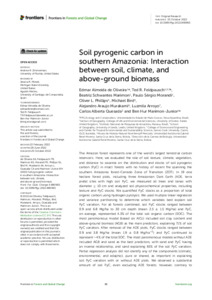Soil pyrogenic carbon in southern Amazonia: Interaction between soil, climate, and above-ground biomass
de Oliveira, Edmar Almeida, Feldpausch, Ted R., Marimon, Beatriz Schwantes, Morandi, Paulo Sérgio, Phillips, Oliver L., Bird, Michael, Murakami, Alejandro Araujo, Arroyo, Luzmila, Quesada, Carlos Alberta, and Marimon-Junior, Ben Hur (2022) Soil pyrogenic carbon in southern Amazonia: Interaction between soil, climate, and above-ground biomass. Frontiers in Forests and Global Change, 5. 880963.
![[img]](https://researchonline.jcu.edu.au/77619/1.hassmallThumbnailVersion/Oliviera_2022%20Amazon%20PyC%20frontiers.pdf)
|
PDF (Published Version)
- Published Version
Available under License Creative Commons Attribution. Download (2MB) | Preview |
Abstract
The Amazon forest represents one of the world’s largest terrestrial carbon reservoirs. Here, we evaluated the role of soil texture, climate, vegetation, and distance to savanna on the distribution and stocks of soil pyrogenic carbon (PyC) in intact forests with no history of recent fire spanning the southern Amazonia forest-Cerrado Zone of Transition (ZOT). In 19 one hectare forest plots, including three Amazonian Dark Earth (ADE, terra preta) sites with high soil PyC, we measured all trees and lianas with diameter ≥ 10 cm and analyzed soil physicochemical properties, including texture and PyC stocks. We quantified PyC stocks as a proportion of total organic carbon using hydrogen pyrolysis. We used multiple linear regression and variance partitioning to determine which variables best explain soil PyC variation. For all forests combined, soil PyC stocks ranged between 0.9 and 6.8 Mg/ha to 30 cm depth (mean 2.3 ± 1.5 Mg/ha) and PyC, on average, represented 4.3% of the total soil organic carbon (SOC). The most parsimonious model (based on AICc) included soil clay content and above-ground biomass (AGB) as the main predictors, explaining 71% of soil PyC variation. After removal of the ADE plots, PyC stocks ranged between 0.9 and 3.8 Mg/ha (mean 1.9 ± 0.8 Mg/ha–1) and PyC continued to represent ∼4% of the total SOC. The most parsimonious models without ADE included AGB and sand as the best predictors, with sand and PyC having an inverse relationship, and sand explaining 65% of the soil PyC variation. Partial regression analysis did not identify any of the components (climatic, environmental, and edaphic), pure or shared, as important in explaining soil PyC variation with or without ADE plots. We observed a substantial amount of soil PyC, even excluding ADE forests; however, contrary to expectations, soil PyC stocks were not higher nearer to the fire-dependent Cerrado than more humid regions of Amazonia. Our findings that soil texture and AGB explain the distribution and amount of soil PyC in ZOT forests will help to improve model estimates of SOC change with further climatic warming.
| Item ID: | 77619 |
|---|---|
| Item Type: | Article (Research - C1) |
| ISSN: | 2624-893X |
| Keywords: | biomass, Cerrado, drought, fire, fire fuel, Holocene, soil organic carbon, Zone of Transition |
| Copyright Information: | © 2022 de Oliveira, Feldpausch, Marimon, Morandi, Phillips, Bird, Murakami, Arroyo, Quesada and Marimon-Junior. This is an open-access article distributed under the terms of the Creative Commons Attribution License (CC BY). The use, distribution or reproduction in other forums is permitted, provided the original author(s) and the copyright owner(s) are credited and that the original publication in this journal is cited, in accordance with accepted academic practice. No use, distribution or reproduction is permitted which does not comply with these terms. |
| Date Deposited: | 15 Feb 2023 03:20 |
| FoR Codes: | 37 EARTH SCIENCES > 3703 Geochemistry > 370304 Organic geochemistry @ 20% 41 ENVIRONMENTAL SCIENCES > 4106 Soil sciences > 410604 Soil chemistry and soil carbon sequestration (excl. carbon sequestration science) @ 80% |
| SEO Codes: | 28 EXPANDING KNOWLEDGE > 2801 Expanding knowledge > 280111 Expanding knowledge in the environmental sciences @ 100% |
| Downloads: |
Total: 534 Last 12 Months: 8 |
| More Statistics |




